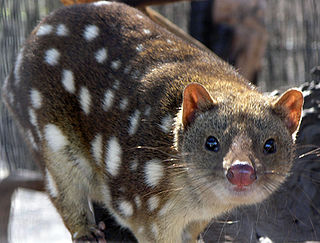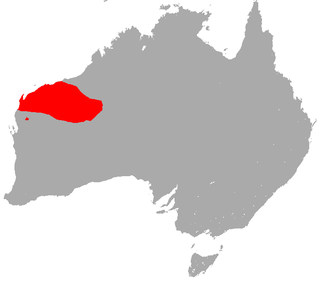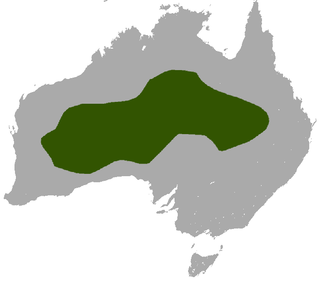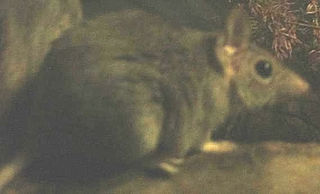
The Dasyuridae are a family of marsupials native to Australia and New Guinea, including 71 extant species divided into 17 genera. Many are small and mouse-like or shrew-like, giving some of them the name marsupial mice or marsupial shrews, but the group also includes the cat-sized quolls, as well as the Tasmanian devil. They are found in a wide range of habitats, including grassland, underground, forests, and mountains, and some species are arboreal or semiaquatic. The Dasyuridae are often called the 'marsupial carnivores', as most members of the family are insectivores.

The long-tailed planigale, also known as Ingram's planigale or the northern planigale, is the smallest of all marsupials, and one of the smallest of all mammals. It is rarely seen but is a quite common inhabitant of the blacksoil plains, clay-soiled woodlands, and seasonally flooded grasslands of Australia's Top End.
The former subfamily Planigalinae contained the planigales and the ningauis: very small marsupial carnivores native to Australia which are, like the quolls, antechinuses, dibblers, Tasmanian devil, and many others, part of the biological order Dasyuromorphia: the carnivorous marsupials. The subfamily is now contained in the Sminthopsinae subfamily, and the two genera are split between two different tribes; the planigales are by themselves in their own tribe, while the ningaui are lumped with the dunnarts and the Kultarr.

The common planigale, also known as the pygmy planigale or the coastal planigale, is one of many small marsupial carnivores known as "marsupial mice" found in Australia. There they fill a similar niche to the insectivores of other parts of the world.

The little red kaluta is a small, reddish-brown, shrew-like mammal native to dry grasslands of northwest Australia. It is active at night, feeding on insects and other small animals. The kaluta is a marsupial and is the only member of its genus, Dasykaluta. Individuals are around 10 cm (3.9 in) long and weigh from 20 to 40 g. They live for about four years in captivity. Other common names include little red antechinus, russet antechinus and spinifex antechinus.

The Wongai ningaui is a tiny carnivorous marsupial native to the arid open grasslands of inland Australia. Their diet is mainly small insects, and occasionally larger prey such as spiders, grasshopperss and cockroaches, which they forage for at the ground and in clumps of spinifex. They have long and untidy fur, grey or gingery brown with longer black hairs, small ears, a narrow muzzle, and possess a partially prehensile tail and feet that allow them to climb. The population occurs sparsely across a wide area and common in favourable habitat, especially in years of good rainfall. Ningaui ridei was first described in 1975, one of two species of a new genus discovered amongst the poorly known mammals of the western regions of Australia.

The subfamily Sminthopsinae includes several genera of small, carnivorous marsupials native to Australia: kultarrs, ningauis, dunnarts, and planigales.

Smintopsini is a tribe of marsupial in the family Dasyuridae.

Woolley's false antechinus, also known as Woolley's pseudantechinus, is a species of small carnivorous marsupial belonging to the family Dasyuridae. It is found in the Australian state of Western Australia, primarily in the Pilbara, Ashburton and Murchison regions.

Rory Cooper's false antechinus, also known as the tan false antechinus and the tan pseudantechinus, is a recently named species of small carnivorous marsupial which inhabits rocky outcrops in Western Australia. Nothing is known of its behaviour but it is expected that this will be similar to other members of the false antechinus genus. A study published in 2017 found no support for separation as a new species of Pseudantechinus, and the name was proposed to be synonymous with the previously described Pseudantechinus macdonnellensis.

The fawn antechinus is a species of small carnivorous marsupial found in northern Australia. It is the only Antechinus to be found in the Northern Territory and has a patchy, restricted range.

The Pilbara ningaui, sometimes known as Ealey's ningaui, is a tiny species of marsupial carnivore found in Australia.

The southern ningaui is a tiny marsupial carnivore belonging to the Dasyuridae family. Similar in appearance to Ningaui ridei, found throughout central Australia, this species occurs in spinifex on semi-arid sandplains across the southern coast of the continent. The fur is a tawny or greyish olive colour, light grey below, and distinguished by shades of cinnamon. The southern ningaui prefers smaller prey, including insects and spiders, but capable of killing and consuming larger animals such as cockroaches and skinks. Their narrow muzzle is used with quick and fierce bites about the head to despatch their meal. The species was first described in 1983, and placed within the genus Ningaui.

The paucident planigale, also known as Giles' planigale, is a very small species of carnivorous marsupial of the family Dasyuridae.

The narrow-nosed planigale is a species of very small marsupial carnivore of the family Dasyuridae.

The genus Planigale are small carnivorous marsupials found in Australia and New Guinea. It is the only genus in the tribe Planigalini of the subfamily Sminthopsinae. There are five species:
Eric Herbert Mitchell "Tim" Ealey, 29 March 1927 - 21 October 2020, was an Australian biologist, known for his contributions to science, the environment and conservation awareness and was the recipient of a Medal of the Order of Australia. Ealey has received international recognition for his works, and nationally acknowledged for a program that involved schools in rehabilitation of the environment. Ealey was commemorated in the specific epithet of a tiny marsupial, Ningaui timealeyi, he discovered in the Pilbara region of Western Australia. Amongst his works was research on the monotreme family of Tachyglossidae, the species of echidnas. Ealey worked for the Antarctic Division in the 1950s, researching the fauna of Heard Island.













